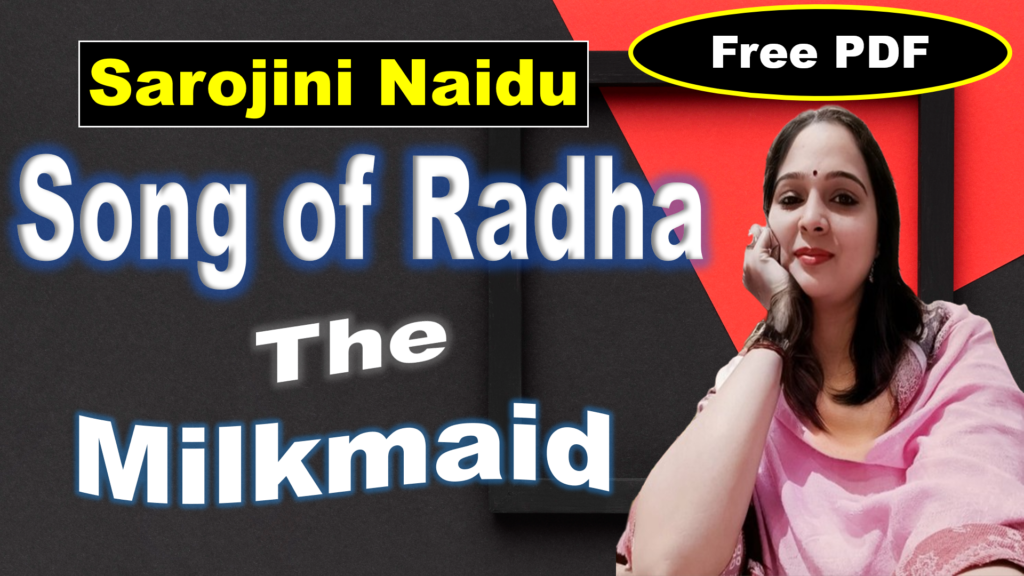
Song of Radha the Milkmaid by Sarojini Naidu | Song of Radha the Milkmaid | Sarojini Naidu | Explanation | Summary | Key Points | Word Meaning | Critical Appreciation | Questions Answers | Free PDF Download – Easy Literary Lessons
Song of Radha, the Milkmaid
I carried my curds to the Mathura fair …
How softly the heifers were lowing …
I wanted to cry, “Who will buy
These curds that are white as the clouds in the sky
When the breezes of shrawan are blowing?”
But my heart was so full of your beauty, Beloved,
They laughed as I cried without knowing:
Govinda! Govinda!
Govinda! Govinda!
How softly the river was flowing!
I carried my pots to the Mathura tide …
How gaily the rowers were rowing! …
My comrades called, “Ho! let us dance, let us sing
And wear saffron garments to welcome the spring.
And pluck the new buds that are blowing.”
But my heart was so full of your music, Beloved,
They mocked when I cried without knowing:
Govinda! Govinda!
Govinda! Govinda!
How gaily the river was flowing!
I carried my gifts to the Mathura shrine …
How brightly the torches were glowing! …
I folded my hands at the altars to pray
“O shining ones guard us by night and by day”—
And loudly the conch shells were blowing.
But my heart was so lost in your worship, Beloved,
They were wroth when I cried without knowing:
Govinda! Govinda!
Govinda! Govinda!
How brightly the river was flowing!
Song of Radha the Milkmaid Analysis
First Stanza
Line 1: I carried my curds to the Mathura fair …
Explanation: Radha, a milkmaid, is carrying her curds to the Mathura fair to sell.
Line 2: How softly the heifers were lowing …
Explanation: As Radha walks, she hears the gentle lowing of cows.
Line 3: I wanted to cry, “Who will buy
Explanation: Radha is feeling anxious about whether or not she will be able to sell her curds.
Line 4: These curds that are white as the clouds in the sky
Explanation: Radha compares the whiteness of her curds to the clouds in the sky.
Line 5: When the breezes of shrawan are blowing?”
Explanation: Radha mentions the breezes of Shrawan, a monsoon month in India.
Line 6: But my heart was so full of your beauty, Beloved,
Explanation: Radha’s thoughts are consumed by her love for Krishna, her beloved.
Line 7: They laughed as I cried without knowing:
Explanation: Radha’s companions laugh at her because they do not understand her sadness.
Line 8: Govinda! Govinda!
Explanation: Radha cries out to Krishna, using his name as a form of prayer.
Line 9: Govinda! Govinda!
Explanation: Radha repeats Krishna’s name, emphasizing her devotion.
Line 10: How softly the river was flowing!
Explanation: Radha notices the gentle flow of the river beside her.
राधा अपने बगल में बहती नदी के कोमल प्रवाह को देखती है।
Second Stanza
Line 1: I carried my pots to the Mathura tide …
Explanation: Radha is carrying her pots filled with curds to the Mathura riverbank.
Line 2: How gaily the rowers were rowing! …
Explanation: As Radha walks along the riverbank, she observes the rowers rowing their boats with great joy.
Line 3: My comrades called, “Ho! let us dance, let us sing
Explanation: Radha’s companions invite her to join them in dancing and singing.
Line 4: And wear saffron garments to welcome the spring.
Explanation: They suggest wearing saffron-colored clothes to celebrate the arrival of spring.
Line 5: And pluck the new buds that are blowing.”
Explanation: They encourage Radha to pick the newly blooming flowers.
Line 6: But my heart was so full of your music, Beloved,
Explanation: Radha’s heart is filled with the melodious sound of Krishna’s flute, her beloved’s music.
Line 7: They mocked when I cried without knowing:
Explanation: Radha’s companions mock her when she cries out to Krishna, unaware of her inner devotion.
Line 8: Govinda! Govinda!
Explanation: Radha passionately calls out to Krishna, using his name as a form of adoration.
Line 9: Govinda! Govinda!
Explanation: She repeats Krishna’s name with deep devotion, emphasizing her love for him.
Line 10: How gaily the river was flowing!
Explanation: Radha observes the river flowing with the same joyous spirit as the rowers’ rowing.
Third Stanza
Line 1: I carried my gifts to the Mathura shrine …
Explanation: Radha is carrying her offerings to the Mathura shrine, a sacred place of worship.
Line 2: How brightly the torches were glowing! …
Explanation: As Radha approaches the shrine, she sees the torches burning brightly, illuminating the surroundings.
Line 3: I folded my hands at the altars to pray
Explanation: Radha stands with folded hands, offering her prayers in reverence and devotion.
Line 4: “O shining ones guard us by night and by day”—
Explanation: Radha prays to the divine beings, seeking their protection throughout the day and night.
Line 5: And loudly the conch shells were blowing.
Explanation: The resonant sound of conch shells echoes through the air, adding to the sacred atmosphere.
Line 6: But my heart was so lost in your worship, Beloved,
Explanation: Radha’s heart is completely absorbed in her devotion to Krishna, her beloved.
Line 7: They were wroth when I cried without knowing:
Explanation: Radha’s companions are angered by her cries of “Govinda! Govinda!” unaware of her deep spiritual connection with Krishna.
Line 8: Govinda! Govinda!
Explanation: Radha’s passionate plea of “Govinda! Govinda!” reflects her unwavering love and devotion to Krishna.
Line 9: Govinda! Govinda!
Explanation: The repetition of Krishna’s name underscores the intensity of Radha’s love and her constant remembrance of him.
Line 10: How brightly the river was flowing!
Explanation: Amidst her devotion, Radha notices the river flowing brightly, symbolizing the continuous flow of life and spirituality.





